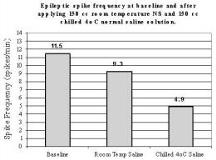CAN [quot]COOLING[quot] THE BRAIN REDUCE SEIZURE DISCHARGE?
Abstract number :
3.102
Submission category :
Year :
2005
Submission ID :
5908
Source :
www.aesnet.org
Presentation date :
12/3/2005 12:00:00 AM
Published date :
Dec 2, 2005, 06:00 AM
Authors :
2Minh Tran, 2Mitchell Isaac, 1David Stigge-Kaufman, 2Steve Werder, 1Toni Sadler, 1Nazih Moufarrij, 1John Gorecki, and 1,2Kore Liow
Seizures can occasionally be induced intraoperatively during cortical mapping during epileptic surgery. Antiepileptic medications (AEDs) are often needed to abort seizures induced, however, the use of AEDs intraoperatively during awake mapping can complicate and prolong surgery time. An alternative method to reduce seizures induced during brain mapping is studied to determine whether cortical cooling is able to reduce the amount of interictal epileptiform activity. This study will help determine if applying chilled solution to exposed cerebral cortex can reduce interictal epileptiform activities. Electrocorticography (ECoG) was used to record the epileptiform activity of 15 patients (ages 15-51) undergoing cortical mapping and resection surgery. Cortical baseline activity was recorded from a subdural strip for each patient and interictal spikes were counted. For the first three patients, 15 cc of room temperature (18oC) Lactated Ringer[apos]s (LR) solution was applied directly to the cortex for 30 seconds, followed by 2 minutes of recording. 15 cc of chilled (4oC) LR solution was then applied to the cortex for 30 seconds, followed by 10 minutes of recording. For the last five patients, the procedure was performed using 150 cc of room temperature normal saline (NS) and 150 cc of chilled (4oC) normal saline. Interictal spikes were counted at baseline and compared with spikes after applying room temperature and chilled LR or normal saline. A standard statistical program (SPSS) was used to perform Wilcoxon Signed-Rank and Mann-Whitney tests on the data. Application of 150 cc chilled (4oC) NS solution reduced the number of interictal spikes from 11.5 to 4.9 spikes/minute (p = 0.004). There was no significant reduction in the epileptic spike frequency when room temperature NS or LR solution was used (p = 0.182, p = 0.285 respectively). The reduction in interictal spikes was more marked when 150 cc of normal saline solution was used than with 15 cc. Application of chilled 4oC normal saline solution to exposed cerebral cortex can reduce interictal epileptiform discharges and can potentially be used to abort seizures induced intraoperatively during brain mapping. The effect is more marked when a larger volume of solution (150cc.) is applied.[figure1] (Supported by University of Kansas Summer Research Training Program, Via Christi Comprehensive Epilepsy Center and Neurophysiology Laboratory, Dept. of Internal Medicine, University of Kansas School of Medicine, Wichita, KS.)
